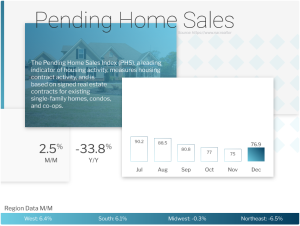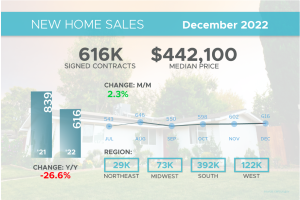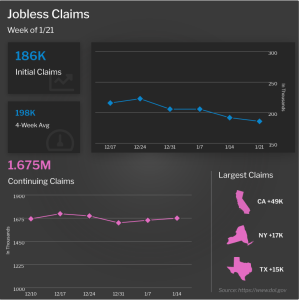
Monday Market Update
Week of January 23, 2023 in Review
Housing activity moved higher in December, inflation continues to cool, and more recession signals are flashing:
- Inflation Turning the Corner
- Pending Home Sales Rise for First Time in Six Months
- New Home Sales Ticked Higher in December
- Caveats to Positive Fourth Quarter GDP
- Initial Jobless Claims Decline for Second Consecutive Week
- Economic Slowdown and Recession Signs Continue
Inflation Turning the Corner
The Fed's favorite measure of inflation, Personal Consumption Expenditures (PCE), showed that headline inflation rose 0.1% in December, while the year-over-year reading declined from 5.5% to 5%. Core PCE, which strips out volatile food and energy prices, rose by 0.3% with the year-over-year change falling from 4.7% to 4.4%.
What's the bottom line? Headline PCE has declined nearly 2% after peaking last June, while Core PCE is down 1% after reaching 5.4% last February. This is a meaningful improvement in inflation, and the decline is expected to continue. Inflation is calculated on a rolling 12-month basis, so the total of the past 12 monthly inflation readings gives us the year-over-year rate of inflation. Readings from the start of last year are higher comparisons, so if we continue to see lower monthly inflation readings, the annual rate of inflation will continue to move lower.
Pending Home Sales Rise for First Time in Six Months

Pending Home Sales rose 2.5% from November to December, ending sixth straight months of declines. However, sales were 33.8% lower than they were a year earlier. This is a critical report for taking the pulse of the housing market, as it measures signed contracts on existing homes, which represent around 90% of the market.
What's the bottom line? Lawrence Yun, chief economist for the National Association of Realtors, noted, "This recent low point in home sales activity is likely over. Mortgage rates are the dominant factor driving home sales, and recent declines in rates are clearly helping to stabilize the market."
New Home Sales Ticked Higher in December

New Home Sales, which measure signed contracts on new homes, rose 2.3% in December to a 616,000-unit annualized pace, which was in line with estimates. Note that there was a negative revision to November's sales that made December's gain appear a bit bigger.
What's the bottom line? December saw a slight decline in mortgage rates, so it makes sense that buyer activity moved higher. And while the median price for new homes fell from $459,000 in November to $442,100 in December, this is not the same as a decline in home prices. The median price simply means half the homes sold were above that price and half were below it, and this figure can be skewed by the mix of sales among lower-priced and higher-priced homes.
Looking closely at inventory, there were 461,000 new homes for sale at the end of December, which equates to a 9 months' supply. However, only 71,000 were completed, with the rest either not started or under construction. The number of completed homes equates to a 1.4 months' supply, well below a balanced market and showing inventory remains tight.
Caveats to Positive Fourth Quarter GDP
The first reading of Gross Domestic Product (GDP) for the fourth quarter of last year showed that the U.S. economy grew by 2.9% annualized, which was higher than estimates. Note that this is the first of three readings and there can be significant revisions when the second and final readings are released on February 23 and March 30, respectively.
What's the bottom line? GDP functions as a scorecard for the country's economic health. Last year, GDP was negative for both the first and second quarters before turning positive in the third. While the positive initial reading for the fourth quarter sounds like good news, there is more to the data than this headline number.
Looking at the internals, inventory build played a big role in the overall figure. Recent data showed that Personal Spending declined in November and December while Retail Sales were weak during the holiday shopping season, leaving companies with excess inventory. As a result, companies may start to slash prices, which could become a drag on the economy and impact GDP in the first and second quarters of this year.
Initial Jobless Claims Decline for Second Consecutive Week

The number of people filing for unemployment benefits for the first time fell by 6,000 in the latest week, as 186,000 Initial Jobless Claims were reported. This marked the second week in a row that Initial Jobless Claims declined, keeping them below 200,000. Continuing Claims, which measure people who continue to receive benefits after their initial claim is filed, rose 20,000 to 1.675 million.
What's the bottom line? Data from the latest Bureau of Labor Statistics Jobs Report showed that companies are reducing workers' hours as opposed to outright letting them go, which may be contributing to the decline in initial unemployment claims. However, Continuing Claims have risen by more than 300,000 over the last four months, which suggests it's becoming harder for many to find a job if they are let go.
Economic Slowdown and Recession Signs Continue
Several reports released last week continue to show that the economy is slowing. The National Association for Business Economics released their January 2023 Business Conditions Survey of 60 of its members firms. The responses showed that profit margins remain under pressure and hiring plans turned negative for the first time since the pandemic. Just over half of respondents felt there was a 50% or higher chance of a recession over the next year.
The Conference Board also released their Leading Economic Index (LEI) for December showing that it fell 1%, following a 1.1% decline in November. This report is a composite of economic indexes and can signal peaks and troughs in the business cycle. Of note, the LEI was down 4.2% from June through December of last year, and it has also been in contraction for 10 months in a row. The Conference Board explained how the rollover in indicators and trajectory over the last six months is a recession signal that has been highly accurate historically.
We are also continuing to see inversions on the yield curve, with 1-month, 3-month, 1-year and 2-year yields all moving higher than 10-year yields. This is unusual as typically you would expect to receive a higher rate of return if you put your money away for 10 years when compared to lesser timeframes. An upside-down yield curve has been a historically accurate recession indicator, as it is a symptom that the economy is slowing.
What's the bottom line? The economy has been slowing in large part because of aggressive action taken by the Fed last year to try to tame runaway inflation, including seven hikes to its benchmark Fed Funds Rate. This is the overnight borrowing rate for banks, and it is not the same as mortgage rates. Raising the cost of borrowing on certain items slows the economy down and incentivizes savings rates, driving down demand and thus curbing inflation, which has begun to cool per recent reports.
Investors will be closely watching what actions the Fed takes to fight inflation at their meeting which begins Tuesday, with the Monetary Policy Statement and press conference coming on Wednesday.
Family Hack of the Week
The start of tax season often brings an uptick in tax-related scams. These reminders from the IRS will help you keep your identity safe all year long.
The IRS will not initiate contact with taxpayers by email to request personal or financial information. If you receive a suspicious IRS, Treasury or tax-related email, do not open any attachments, click on any links, or reply to the sender.
The IRS will also not leave pre-recorded, urgent or threatening messages for taxpayers or threaten to bring in the police to have them arrested or deport them. The IRS will not call to demand immediate payment with a prepaid debit card, gift card or wire transfer, nor will the IRS request checks be sent to third parties.
The IRS also does not demand payment without giving taxpayers the chance to question or appeal the amount owed.
The IRS reminds people that scammers can fake or spoof an IRS office phone number or the numbers of various local, state, federal or tribal government agencies. If you ever receive a suspicious phone call, the IRS advises that you hang up immediately without giving any personal information.
What to Look for This Week
Updates on housing, jobs and the Fed meeting highlight a busy week ahead. On Tuesday, look for home price appreciation data for November from the Case-Shiller Home Price Index and the Federal Housing Finance Agency (FHFA) House Price Index.
From the labor sector, ADP's Employment Report will give us an update on private payrolls for January when it is released on Wednesday. The latest Jobless Claims data will be reported on Thursday while Friday brings the Bureau of Labor Statistics Jobs Report for January, which includes Non-farm Payrolls and the Unemployment Rate.
As noted above, the Fed's two-day meeting begins Tuesday, with the Monetary Policy Statement and press conference coming on Wednesday.
Technical Picture
Mortgage Bonds have been trading somewhat sideways since the beginning of the year, trapped between a dual floor of support formed by the 25-day and 50-day Moving Averages and overhead resistance at the formidable 101.671 Fibonacci level. This is a wide range, so we can see some big price fluctuations while Bonds remain in it. The 10-Year is trading right in the middle of a range comprised of a ceiling at the 25-day and 50-day Moving Averages and a floor at the 3.431% Fibonacci Level.
Source: https://mbshighway.com

